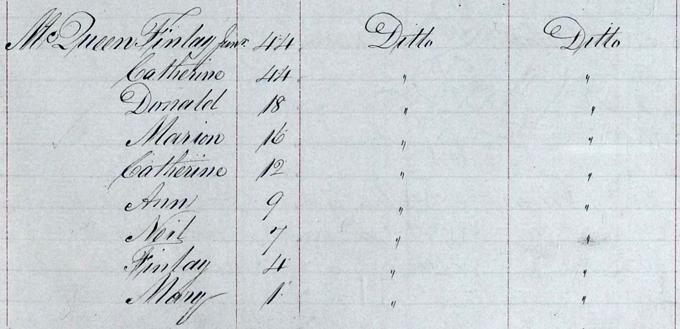In September 1852, 36 inhabitants of St Kilda left for Australia on board the ‘Priscilla’. The ship was carrying migrants under a new scheme funded by the Highland and Island Emigration Society, whose records are available in Scotland's People. This scale of emigration was unprecedented in the remote island’s history, and not repeated until the evacuation of 1930. Amongst the emigrants was the McQueen family; Finlay McQueen senior travelled with three grown children, and Finlay McQueen junior and his wife Catherine had seven children aged between 1 and 18. For a family to have this many surviving children, on an island with high neonatal deaths, was unusual.
The McQueen [McQuien] family in the 1851 census
National Records of Scotland, 1851 Census, 111/18/5
The census entry lists Finlay McQueen as a 'farmer of 3 acres & bird catcher employing no labourer.' In the summer months, the inhabitants of St Kilda would hunt and catch young gannets, aulks and fulmars which were the primary food source on the island, rather than fish. Their feathers were used to stuff bedding, and the oil in their stomachs was used as fuel and medicine.
Compared to other emigrants, the St Kildans didn’t carry the same marks of extreme poverty. Another family of the same name travelling on the ‘Priscilla’ from Portree in Skye, for example, were noted as being a ‘very destitute family’. It was recorded by the HIES that John McLeod, the landlord, had paid for their outfits and the deposits for their travel. The emigrants sailed to Skye, where they stayed for two weeks, before taking a vessel to the Broomielaw in Glasgow, where they arrived on 1st October. The ship ‘Princess Royal’ took them to Birkenhead where they waited for several weeks before boarding the ‘Priscilla’. The group were praised for ‘the simplicity of their manners, their gratitude and above all their piety.’

The McQueen family listed as passengers on board the Priscilla
National Records of Scotland, Records of the Highland and Islands Emigration Society, HD4/5 page 54
The voyage from Birkenhead to Port Phillip lasted 98 days – a journey that witnessed many deaths and sickness, primarily caused by measles. The McQueen family were amongst those who suffered losses. As Eric Richards notes, the St Kildans accounted for 12% of the passengers but 45% of the fatalities. This shows that the population of the remote island had not built up a resistance to measles. The ‘Priscilla’ reached Port Phillip at a time of intense immigration and brought with her a tiny percentage of the 93,000 people entering each year.
The medical officer at the port recorded that the McQueen family ‘were from St Kilda and originally consisted of nine individuals, of whom the father, mother and one child are dead leaving six orphans viz. Donald aged 18 recovering from Scarlatina, Meron 8 ill of anasarca, Niell aged 6 and Findlay aged 3 dying of marasmus.’ Finlay died the following day. The McQueens encountered further difficulty when, as Dr Hunt, the health officer noted, ‘They have had the misfortune to lose all their clothes by the burning of the bush hut the four younger ones were living in, so that they have nothing but the filthy rags which scarce cover them, left.’
After some time, Donald McQueen went to Melbourne, and the other young orphans were noted as going ‘with friends’. Richards notes that Anne McQueen, aged 9, worked for a family in Little Collins Street in Melbourne and Malcolm McQueen, aged 24, went to work in the Brighton/Mordialloc district for 9 months making bricks. He married a woman from Raasay and established himself as a market gardener in Victoria.
The final death toll among the original 36 emigrants was probably 19, leaving 17 survivors. By October 1853 the devastating news had reached the island of St Kilda, but the remaining inhabitants never received a full explanation of why so many of their family and friends had died.
Further reading: 'From Hirta to Port Phillip. The story of the ill-fated emigration from St Kilda to Australia in 1852' by Eric Richards (Islands Book Trust, 2010)
Discover how the Highland and Island Emigration Society helped other Scots migrate to Australia in the 1850s.
Read about the last inhabitants of St Kilda in 1930
Learn about St Kilda's history in records in National Records of Scotland